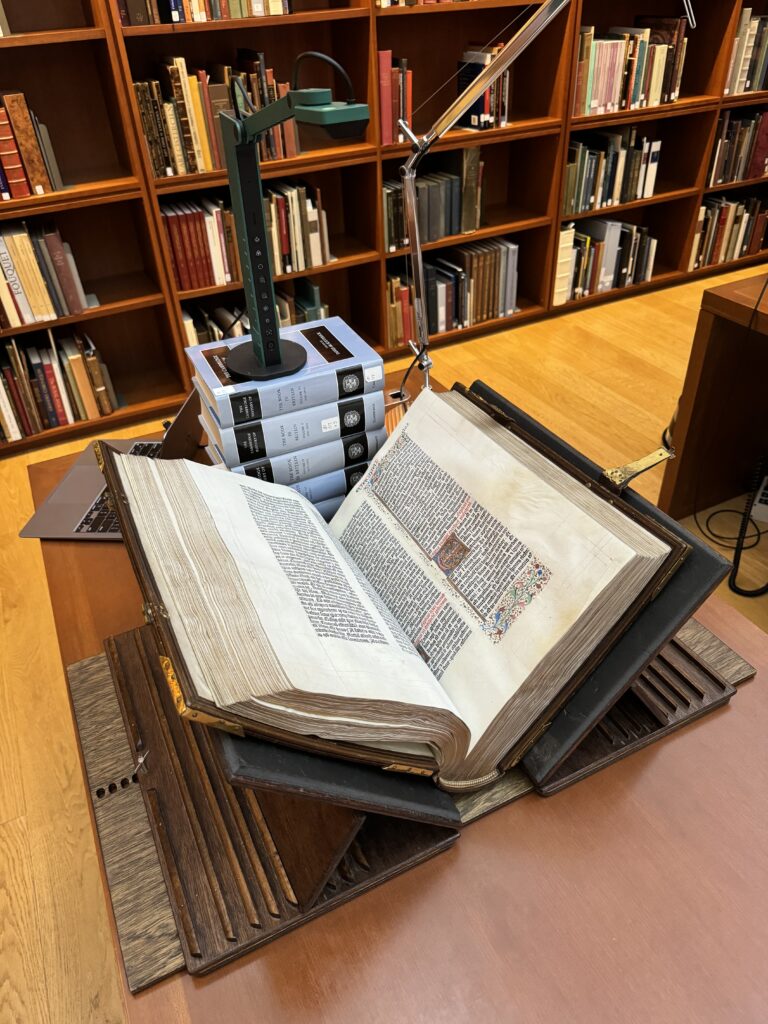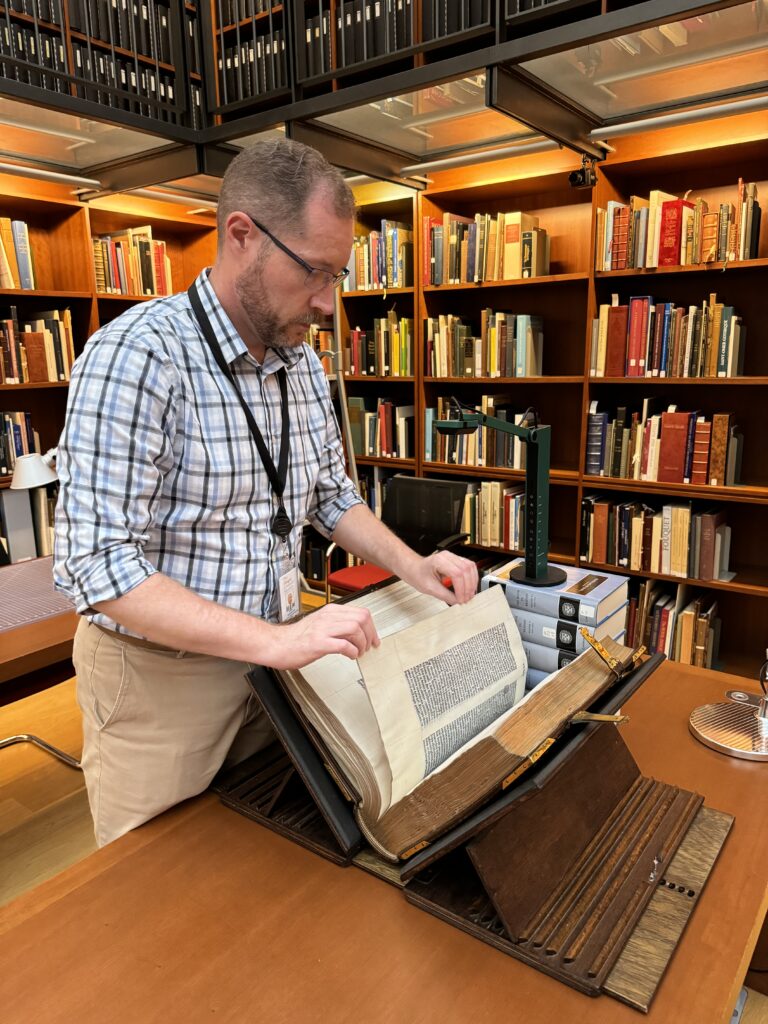
Virtual reading rooms (VRRs) started to become more common during closures due to Covid-19, as institutions increasingly created set-ups to allow for interactions with librarians who can facilitate live, responsive research, in real time, with physical objects. Now, we hope they will become embedded in research, teaching, research-led teaching, and public engagement. Virtual access allows our students, from across many time zones, to explore printed books and ephemera in a way that would be impossible in person. Participant-directed interactions allows them to see, hear, and understand the materiality of these books—how they were produced, and why—in a way that could not be replicated in person. More importantly, it lets them see the scope for their own research and contributions to scholarship, even in a research avenue as well-trodden as that of the Gutenberg Bible.
Much of the discussion about VRRs for research and teaching has focused on more common material, not least because research and teaching with highly valuable, rare, and restricted artefacts has by default been in person. This is especially the case for specialist research and teaching related to their materiality. But this model is exclusionary. It demands the health, personal and professional circumstances, and wealth for travel as well as connections to be granted access, while causing an ecological impact. Of course, in-person research is necessary in some cases, and VRRs require both heritage collections to invest in staff and resources and academics to shift their thinking. When I had the opportunity to teach about the making of the Gutenberg Bible, virtual teaching was my first-choice option, not a distant second-best.
I teach topics related to books printed in a press in Europe before 1500 at the London Rare Books School. As the name suggests, it was founded to allow students to learn from books—that is, the physical, historical objects—in a radical break from theory-based academic practices at the time. Remote teaching for LRBS might seem an oxymoron. But when teaching moved online due to Covid-19, I leapt at the chance to create a module based on remote access to Gutenberg Bibles with Eric White (Scheide Librarian, Princeton University).
Thanks to the generosity of custodians of Gutenberg Bibles and their institutional set-ups for remote access, including at Princeton University Library and the Morgan Library & Museum, New York, our students were able to complement readings, lectures, and discussions with self-directed ‘guided tours’ through an incredible five copies of the Gutenberg Bible, as well as Gutenberg’s even rarer earlier publications: fragments of a Latin grammar textbook and indulgence forms that he produced when he was refining his workflow and building up capital for his giant Bible project. This was not just a once-in-a-lifetime chance; our students gained first-hand knowledge of more copies of the Gutenberg Bible than (almost) everyone who has ever lived.
Virtual access brought significant benefits for teaching the materiality of print heritage over the use of photographs and digital facsimiles. When human hands turn the folios, these books come to life. It takes training to extrapolate the size of an object from a scale bar, which typically indicates millimeters, in photographs. The incredible heft of the Gutenberg Bible’s two huge volumes was communicated by the effort to lift and position them under cameras that could not accommodate their full dimensions. Seeing the hands of curators handle and open the Gutenberg Bibles immediately communicated the scale and robustness of mammoth books in a way that even the highest-quality digitized facsimiles cannot. It also made concrete the vastness of Gutenberg’s investment and project management tasks; in just one of the parchment copies, students saw the skins, and sometimes hairs, of roughly 170 calves.

As students navigated the very different copies, they considered that each Gutenberg Bible’s glittery printing inks and 24k gold decorations are a half-millennium old but can seem ephemeral. This information is easily lost in reproductions due to the well-known impediments of photographing gold in heritage objects. Even the highest quality digital facsimiles can ‘flatten’ the sheet, distorting printed, painted, and written content into an idealised, rectangular form that is far removed from the natural, dynamic, shifting shape inherent to a book. The set-ups and camera angles allowed for varied lighting conditions that brought the gold paint and goldleaf to life, revealing details and textures in real time as leaves ‘danced’, or curved as they were turned.
Students took screenshot after screenshot, capturing copy-specific information that is not available in static photographs. Even if they had been granted physical access to a copy, they would not have been able to document the information that is revealed fleetingly while the leaves are in motion, under lighting conditions that capture the gleam and sparkle of the gold as well as the shadows.
A surprise was the unexpected soundtrack. During my in-person research with copies of the Gutenberg Bible, I have been struck by the noise produced by turning the paper leaves. This distinctive rich percussion is produced by the very heavy animal glue sizing (protective coating) that is typical of mid-15th-century paper from northern Europe. In the virtual set-up, microphones amplified it to the point that students listened intently to the concert, a drumroll with effervescent top notes underpinned by a deep rumble. Students heard Gutenberg’s paper ‘speak’ about how the luxury of these Bibles intersected with the practical functions of their day job.
The noise of the paper copies of the Gutenberg Bible also served as a reminder that this book is part-printed, part-manuscript. Without the sizing, the scribes’ water-based writing ink for the initials and rubrics (red metatext, such as chapter headings) and the decorators’ water-based paints for decorated initials and imagery would bleed and feather. The printed text would be incomplete without the added texts, and the margins of this ‘printed manuscript’, as it were, were left bare to accommodate decorations and imagery. In person, the sound can be obscured by even minimal background noise. But in virtual settings, it resonated across the centuries to give students insights into both the research value of sensorial experiences and the manufacture and use of these Bibles.
This sensory discovery of the materiality of Gutenberg’s first publications and Bible would not have been possible in person, not least given the security restrictions and the geographic spread of both students and Bibles. Even if it were, the close exploration of the inks, paints, gilding, dirt, and other physical traces of production and use under varying lighting conditions would not have been possible; a special collections librarian zooming in from a distant camera bears significantly less risk to the artifact than a group of researchers hovering hand-held magnifiers close to the surface.
The investigation of the materiality of the Gutenberg Bible, and Gutenberg’s earlier print projects, would not have been possible from static photographs or printed facsimiles. Fittingly, one communication revolution is needed to appreciate another.
I thank Eric White for his contributions to this text.
This post derives from a talk presented at the ‘International Sprint Relay Symposium: Creating a Community-Driven Toolkit for the Development and Delivery of Virtual Reading Room Services’, hosted by Research Libraries UK in affiliation with the International Alliance of Research Library Associations (IARLA) on 25 October 2022, https://www.rluk.ac.uk/international-sprint-relay-symposium-creating-a-toolkit-for-vrr-services/ .

